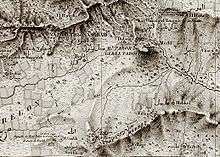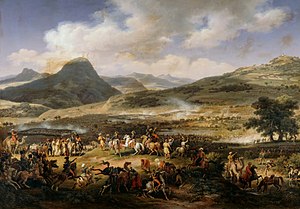Battle of Mount Tabor (1799)
The Battle of Mount Tabor, also known as the Skirmish of Mount Tabor, was an engagement between French forces under Jean Baptiste Kléber, aided in the second part of the battle by reinforcements lead by General Bonaparte, which defeated an Ottoman force led by Abdullah Pasha al-Azm of Damascus on 16 April 1799. Napoleon Bonaparte was besieging Acre, the Ottoman governor of Damascus sent an army to relieve the siege, and Kléber sought to intercept it.

Background
After successful reconnaissance by French scouts, Kléber decided to surprise the main Ottoman force of about 35,000 men (25,000 cavalry – many of them Mamluks, 10,000 infantry and the Pasha), which he had come across camped below Mount Tabor in the Plain of Esdraelon - south of Murat, with just a division of approximately 2,000 men in a night raid. He hoped this action would maintain his favour with Napoleon. Kléber had a reasonable expectation of victory, with his peers and himself being outnumbered and winning previous battles where the enemy knew of their presence. He decided upon a night attack on 15 April: he would circle the northern side of Mount Tabor and raid the Ottoman camp. In Kléber’s headquarters was General Verdier's wife, Verdier commanding a brigade during the forthcoming battle. Kléber sent dispatches to Napoleon about the forthcoming action which would reach him around the time of the battle but not give him a chance to intervene beforehand. Once Napoleon received the dispatches, he decided to support and reinforce Kléber with a few thousand men that were based around Acre, but these were nowhere near enough, even with the 2,000 under Kléber, to defeat the Pasha’s main army in a set piece battle.
Kléber marched east from Nazareth, circling Mount Tabor, keeping west of the Jordan River. Unfortunately Kléber badly estimated how long it would take him to reach the Ottoman camp, and at the break of dawn (at around six o'clock) he was at the southern base of Mount Tabor. The Ottoman forces spotted Kléber's soldiers in the growing daylight, and Kléber realised that his best bet was to form two infantry squares to preserve as many men as possible. It would have been difficult for him to quickly move to any prominent position, although if he had moved much closer to the river, this would have helped his logistical position (with nearby/closer water) and tactical position (with the Ottomans struggling to attack through/from the water). Despite that he could have reached musket range of the river's edge before the Ottoman forces reached him. Another option would have been to attempt to climb Mount Tabor as high as possible in his limited amount of time.
Battle
From 6am to 4pm the French withstood repeated Ottoman charges. They suffered few casualties and easily held their square, but as the day wore on, their ammunition ran low and the men suffered from thirst and hunger. The Ottomans suffered substantial losses, but they could easily replace their casualties and, with good supplies and strength, continue repeated strikes throughout the day.
Just when all seemed to be lost, and Kléber prepared for a last-ditch breakout towards the Jordan, some soldiers claimed to have briefly seen a military force advancing from the north. Kléber tried to verify their report, which could have been a relief column under Napoleon, but could not confirm it. However, a moment later Kléber saw the relief column: the first time Kléber had looked for it, the relief column, under the personal command of Napoleon Bonaparte, had marched into a dip. In spite of the arriving relief force, the Ottomans still had many times more men than Napoleon and Kléber together.
Napoleon found himself between the Ottomans and their camp. He decided to distract the Ottomans by detaching 300 men to pillage and destroy the camp. This was far more successful than Napoleon could have imagined: upon seeing the destruction of their belongings, the Ottomans assumed they were surrounded. In response, the Ottoman army began to retreat to the south and cross the River Jordan. Kléber ordered his men to charge in a last effort for the day, and supported by the rest of the soldiers under Napoleon – who were relatively fresh – this charge transformed the Ottoman retreat into a general rout.
Aftermath
Overall Kléber's casualties were, according to his own account, two dead and seventeen wounded, but had Napoleon arrived just an hour later, his casualties would have been far more serious. On the other hand, the Ottomans, although estimates can not be relied upon, had lost a large proportion of their overall force. This victory not only ended any major threat of the Pasha's army lifting the siege of Acre, but the surviving Ottoman land forces were scattered and did not reform before Napoleon was forced to lift the siege the following month.
Notes
- Bonnet Saint-Georges, Bénédicte (2012). "The Napoleonic Wars. Louis François Lejeune, General and Painter. Exhibition. Château Versailles, 14 February-13 May 2012. Curator: Valérie Bajou, author of Les Guerres de Napoléon. Louis François Lejeune, general et peintre, Editions Hazan, 2012, ISBN: 9782754106023". La Tribune de l'Art. Retrieved 10 May 2020.
He did not travel to Egypt either, nor to Syria but represented the battles of the Pyramids (1798), of Mount Tabor (1799), and the second battle of Aboukir Bay (1799).... Lejeune analyzes, breaks down and details the maneuvers with an aerial perspective which gives the illusion of continuing beyond the canvas, much like the principle of a panorama.
- Charles River Editors (2018). Napoleon in Egypt: The History and Legacy of the French Campaign in Egypt and Syria. Charles River Editors. ISBN 978-1718863620.
- Smith, D. p.151
- Bonaparte et l'Égypte: feu et lumières p117
- Bonaparte et l'Égypte: feu et lumières p117
References
- Smith, D. The Greenhill Napoleonic Wars Data Book. Greenhill Books, 1998.
Further reading
- Heege, Robert (July 2014). "Napoleon's Dramatic Rescue". Military Heritage Magazine.
External links
| Wikimedia Commons has media related to Battle of Mount Tabor (1799) in art. |
- Napoleonic guide - description of the battle
- Battle of Mount Tabor with detailed map. At Napoléon & Empire website. Accessed 10 May 2020.
- Napoleon Wins the Battle of Mount Tabor, with recent photo of the battleground. At Segula magazine. Accessed 10 May 2020.
